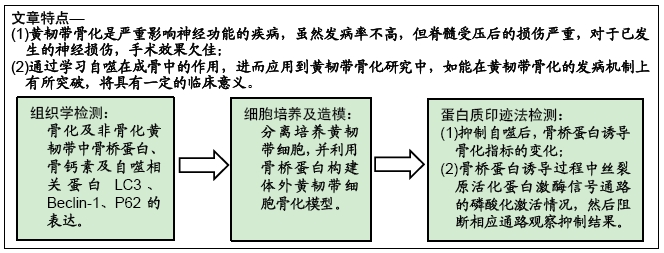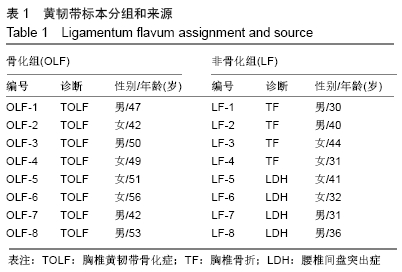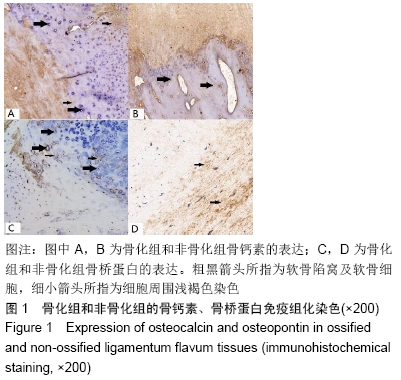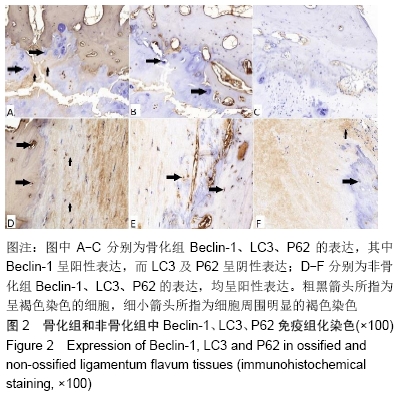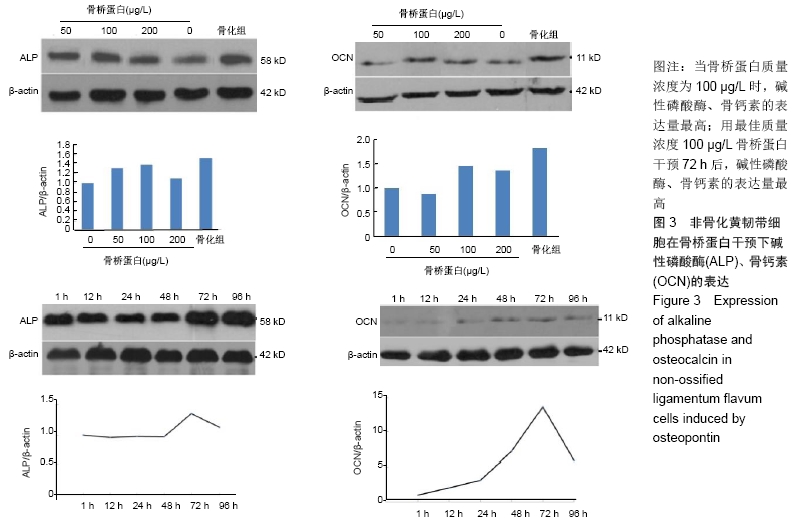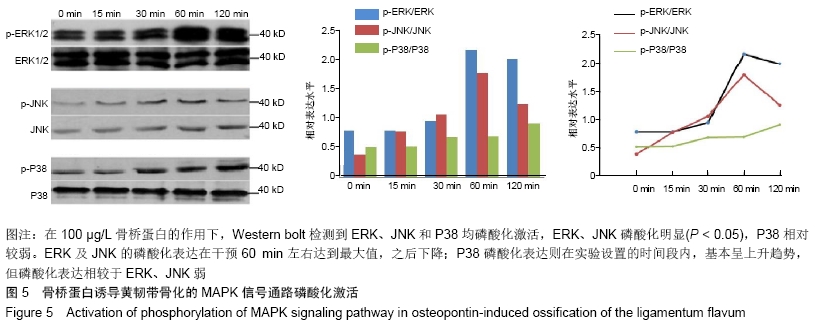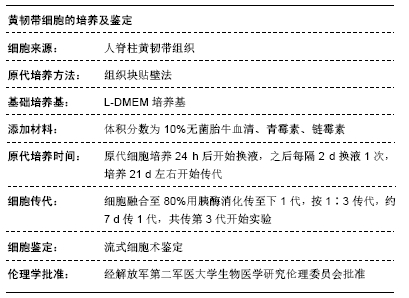[1] EPSTEIN NE. Ossification of the yellow ligament and spondylosis and/or ossification of the posterior longitudinal ligament of the thoracic and lumbar spine. J Spinal Disord. 1999;12(3):250-256.
[2] GUO JJ, LUK KD, KARPPINEN J, et al. Prevalence, distribution, and morphology of ossification of the ligamentum flavum: a population study of one thousand seven hundred thirty-six magnetic resonance imaging scans. Spine (Phila Pa 1976). 2010;35(1):51-56.
[3] INAMASU J, GUIOT BH. A review of factors predictive of surgical outcome for ossification of the ligamentum flavum of the thoracic spine. J Neurosurg Spine. 2006;5(2):133-139.
[4] QU X, CHEN Z, FAN D, et al. Notch signaling pathways in human thoracic ossification of the ligamentum flavum. J Orthop Res. 2016;34(8):1481-1491.
[5] JUNAID A, MOON MC, HARDING GE, et al. Osteopontin localizes to the nucleus of 293 cells and associates with polo-like kinase-1. Am J Physiol Cell Physiol. 2007;292(2): C919-926.
[6] MORINOBU M, ISHIJIMA M, RITTLING SR, et al. Osteopontin expression in osteoblasts and osteocytes during bone formation under mechanical stress in the calvarial suture in vivo. J Bone Miner Res. 2003;18(9):1706-1715.
[7] BOULEFTOUR W, BOUET G, GRANITO RN, et al. Blocking the expression of both bone sialoprotein (BSP) and osteopontin (OPN) impairs the anabolic action of PTH in mouse calvaria bone. J Cell Physiol. 2015;230(3):568-577.
[8] WONGKHANTEE S, YONGCHAITRAKUL T, PAVASANT P. Mechanical stress induces osteopontin expression in human periodontal ligament cells through rho kinase. J Periodontol. 2007;78(6):1113-1119.
[9] ZAHM AM, BOHENSKY J, ADAMS CS, et al. Bone cell autophagy is regulated by environmental factors. Cells Tissues Organs. 2011;194(2-4):274-278.
[10] DANCOURT J, MELIA TJ. Lipidation of the autophagy proteins LC3 and GABARAP is a membrane-curvature dependent process. Autophagy. 2014;10(8):1470-1471.
[11] YANG Z, KLIONSKY DJ. An overview of the molecular mechanism of autophagy. Curr Top Microbiol Immunol. 2009; 335:1-32.
[12] BARTH S, GLICK D, MACLEOD KF. Autophagy: assays and artifacts. J Pathol. 2010;221(2):117-124.
[13] MIZUSHIMA N, YOSHIMORI T, LEVINE B. Methods in mammalian autophagy research. Cell. 2010;140(3):313-326.
[14] KLIONSKY DJ, EMR SD. Autophagy as a regulated pathway of cellular degradation. Science. 2000;290(5497):1717-1721.
[15] FURUYA N, YU J, BYFIELD M, et al. The evolutionarily conserved domain of Beclin 1 is required for Vps34 binding, autophagy and tumor suppressor function. Autophagy. 2005; 1(1):46-52.
[16] INOUE H, SEICHI A, KIMURA A, et al. Multiple-level ossification of the ligamentum flavum in the cervical spine combined with calcification of the cervical ligamentum flavum and posterior atlanto-axial membrane. Eur Spine J. 2013;22 Suppl 3:S416-20.
[17] 李学斌,许政,周盛源,等.丝裂原活化蛋白激酶信号通路在骨桥蛋白介导黄韧带骨化中的作用[J].中国组织工程研究, 2017, 21(28):4469-4474.
[18] FAN D, CHEN Z, CHEN Y, et al. Mechanistic roles of leptin in osteogenic stimulation in thoracic ligament flavum cells. J Biol Chem. 2007;282(41):29958-29966.
[19] CAI HX, YAYAMA T, UCHIDA K, et al. Cyclic tensile strain facilitates the ossification of ligamentum flavum through β-catenin signaling pathway: in vitro analysis. Spine (Phila Pa 1976). 2012;37(11):E639-646.
[20] MIKAWA Y, HAMAGAMI H, SHIKATA J, et al. Elastin in the human intervertebral disk. A histological and biochemical study comparing it with elastin in the human yellow ligament. Arch Orthop Trauma Surg. 1986;105(6):343-349.
[21] ZAKI SM. Study of the human ligamentum flavum in old age: a histological and morphometric study. Folia Morphol (Warsz). 2014;73(4):492-499.
[22] SHUNZHI Y, ZHONGHAI L, NING Y. Mechanical stress affects the osteogenic differentiation of human ligamentum flavum cells via the BMP‑Smad1 signaling pathway. Mol Med Rep. 2017;16(5):7692-7698.
[23] YANG X, CHEN Z, MENG X, et al. Angiopoietin-2 promotes osteogenic differentiation of thoracic ligamentum flavum cells via modulating the Notch signaling pathway. PLoS One. 2018; 13(12):e0209300.
[24] CHAO YH, HUANG SY, YANG RC, et al. Tissue transglutaminase is involved in mechanical load-induced osteogenic differentiation of human ligamentum flavum cells. Connect Tissue Res. 2016;57(4):307-318.
[25] NING S, CHEN Z, FAN D, et al. Genetic differences in osteogenic differentiation potency in the thoracic ossification of the ligamentum flavum under cyclic mechanical stress. Int J Mol Med. 2017;39(1):135-143.
[26] SAIRYO K, BIYANI A, GOEL V, et al. Pathomechanism of ligamentum flavum hypertrophy: a multidisciplinary investigation based on clinical, biomechanical, histologic, and biologic assessments. Spine (Phila Pa 1976). 2005;30(23): 2649-2656.
[27] YIN X, CHEN Z, GUO Z, et al. Tissue transglutaminase expression and activity in human ligamentum flavum cells derived from thoracic ossification of ligamentum flavum. Spine (Phila Pa 1976). 2010;35(20):E1018-1024.
[28] LIU Y, ZHAO Y, CHEN Y, et al. RUNX2 polymorphisms associated with OPLL and OLF in the Han population. Clin Orthop Relat Res. 2010;468(12):3333-3341.
[29] ZHONG ZM, CHEN JT, ZHANG Y, et al. Growth/differentiation factor-5 induces osteogenic differentiation of human ligamentum flavum cells through activation of ERK1/2 and p38 MAPK. Cell Physiol Biochem. 2010;26(2):179-186.
[30] ZHANG C, CHEN Z, MENG X, et al. The involvement and possible mechanism of pro-inflammatory tumor necrosis factor alpha (TNF-α) in thoracic ossification of the ligamentum flavum. PLoS One. 2017;12(6):e0178986.
[31] 杨晓曦,陈仲强.胸椎黄韧带骨化易感基因及蛋白质组学研究进展[J].中国脊柱脊髓杂志,2018,28(6):562-566.
[32] YAYAMA T, MORI K, OKUMURA N, et al. Wnt signaling pathway correlates with ossification of the spinal ligament: A microRNA array and immunohistochemical study. J Orthop Sci. 2018;23(1):26-31.
[33] YIN J, ZHUANG G, ZHU Y, et al. MiR-615-3p inhibits the osteogenic differentiation of human lumbar ligamentum flavum cells via suppression of osteogenic regulators GDF5 and FOXO1. Cell Biol Int. 2017;41(7):779-786.
[34] QU X, CHEN Z, FAN D, et al. MiR-199b-5p inhibits osteogenic differentiation in ligamentum flavum cells by targeting JAG1 and modulating the Notch signalling pathway. J Cell Mol Med. 2017;21(6):1159-1170.
[35] QU X, CHEN Z, FAN D, et al. Notch signaling pathways in human thoracic ossification of the ligamentum flavum. J Orthop Res. 2016;34(8):1481-1491.
[36] BOULEFTOUR W, BOUET G, GRANITO RN, et al. Blocking the expression of both bone sialoprotein (BSP) and osteopontin (OPN) impairs the anabolic action of PTH in mouse calvaria bone. J Cell Physiol. 2015;230(3):568-577.
[37] CHEN Q, SHOU P, ZHANG L, et al. An osteopontin-integrin interaction plays a critical role in directing adipogenesis and osteogenesis by mesenchymal stem cells. Stem Cells. 2014; 32(2):327-337.
[38] INOUE M, SHINOHARA ML. Intracellular osteopontin (iOPN) and immunity. Immunol Res. 2011;49(1-3):160-172.
[39] RANGASWAMI H, BULBULE A, KUNDU GC. Osteopontin: role in cell signaling and cancer progression. Trends Cell Biol. 2006;16(2):79-87.
[40] CHEN Q, SHOU P, ZHANG L, et al. An osteopontin-integrin interaction plays a critical role in directing adipogenesis and osteogenesis by mesenchymal stem cells. Stem Cells. 2014; 32(2):327-337.
[41] 许政,周盛源,李学斌,等.骨桥蛋白及其受体在黄韧带骨化症黄韧带细胞中的表达及其意义[J].中国组织工程研究,2016,20(2): 179-184.
[42] FRANZÉN A, HEINEGÅRD D. Isolation and characterization of two sialoproteins present only in bone calcified matrix. Biochem J. 1985;232(3):715-724.
[43] HIROTA S, ASADA H, KOHRI K, et al. Possible role of osteopontin in deposition of calcium phosphate in human pilomatricomas. J Invest Dermatol. 1995;105(1):138-142.
[44] WONGKHANTEE S, YONGCHAITRAKUL T, PAVASANT P. Mechanical stress induces osteopontin expression in human periodontal ligament cells through rho kinase. J Periodontol. 2007;78(6):1113-1119.
[45] SODEK KL, TUPY JH, SODEK J, et al. Relationships between bone protein and mineral in developing porcine long bone and calvaria. Bone. 2000;26(2):189-198.
[46] 杨戈,林迭生,练克俭.自噬与骨组织及骨类疾病[J].国际骨科学杂志,2014,35 (3):181-183.
[47] KIM KH, LEE MS. Autophagy--a key player in cellular and body metabolism. Nat Rev Endocrinol. 2014;10(6):322-337.
[48] CARAMÉS B, HASEGAWA A, TANIGUCHI N, et al. Autophagy activation by rapamycin reduces severity of experimental osteoarthritis. Ann Rheum Dis. 2012;71(4): 575-581.
[49] JU JS, WEIHL CC. Inclusion body myopathy, Paget's disease of the bone and fronto-temporal dementia: a disorder of autophagy. Hum Mol Genet. 2010;19(R1):R38-45.
[50] HOCKING LJ, WHITEHOUSE C, HELFRICH MH. Autophagy: a new player in skeletal maintenance?J Bone Miner Res. 2012; 27(7):1439-1447.
[51] ZHAO H,XIONG J,ONAL M,et al. Osteocyte autophagy declines with age in mice and suppression of autophagy decreases bone mass. J Bone Min Res. 2012;26(Abstract): 1039.
[52] DAI JP, ZHAO XF, ZENG J, et al. Drug screening for autophagy inhibitors based on the dissociation of Beclin1-Bcl2 complex using BiFC technique and mechanism of eugenol on anti-influenza A virus activity. PLoS One. 2013; 8(4):e61026.
[53] KIM JH, HONG SK, WU PK, et al. Raf/MEK/ERK can regulate cellular levels of LC3B and SQSTM1/p62 at expression levels. Exp Cell Res. 2014;327(2):340-352.
[54] SIVAPRASAD U, BASU A. Inhibition of ERK attenuates autophagy and potentiates tumour necrosis factor-alpha-induced cell death in MCF-7 cells. J Cell Mol Med. 2008;12(4):1265-1271.
[55] NI BB, LI B, YANG YH, et al. The effect of transforming growth factor β1 on the crosstalk between autophagy and apoptosis in the annulus fibrosus cells under serum deprivation. Cytokine. 2014;70(2):87-96.
|
